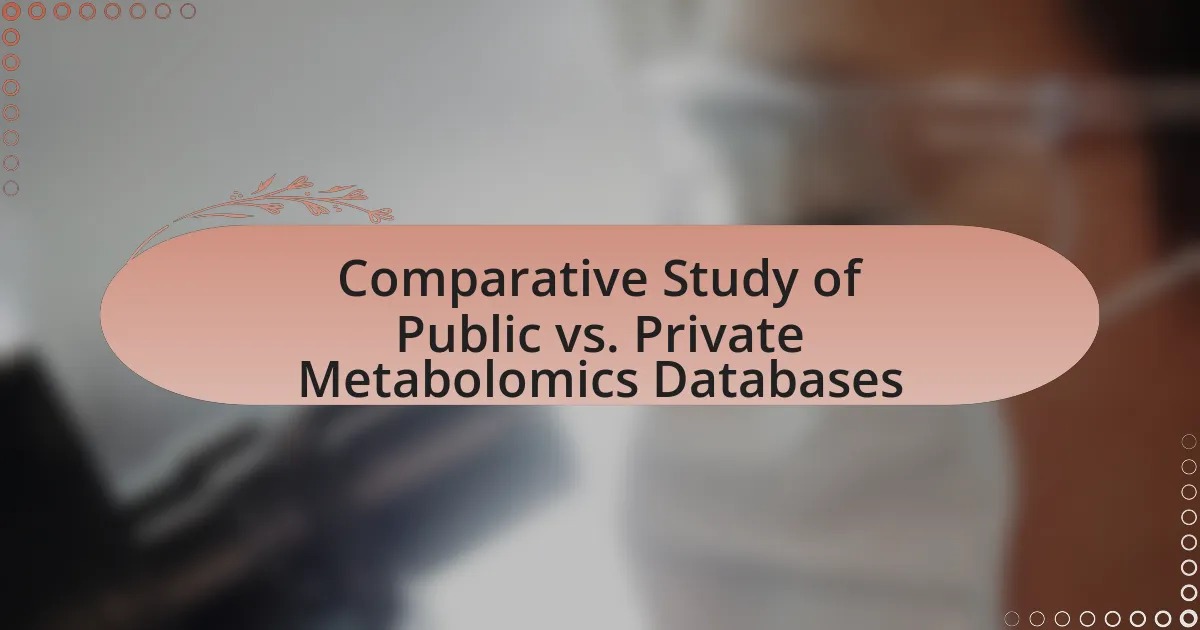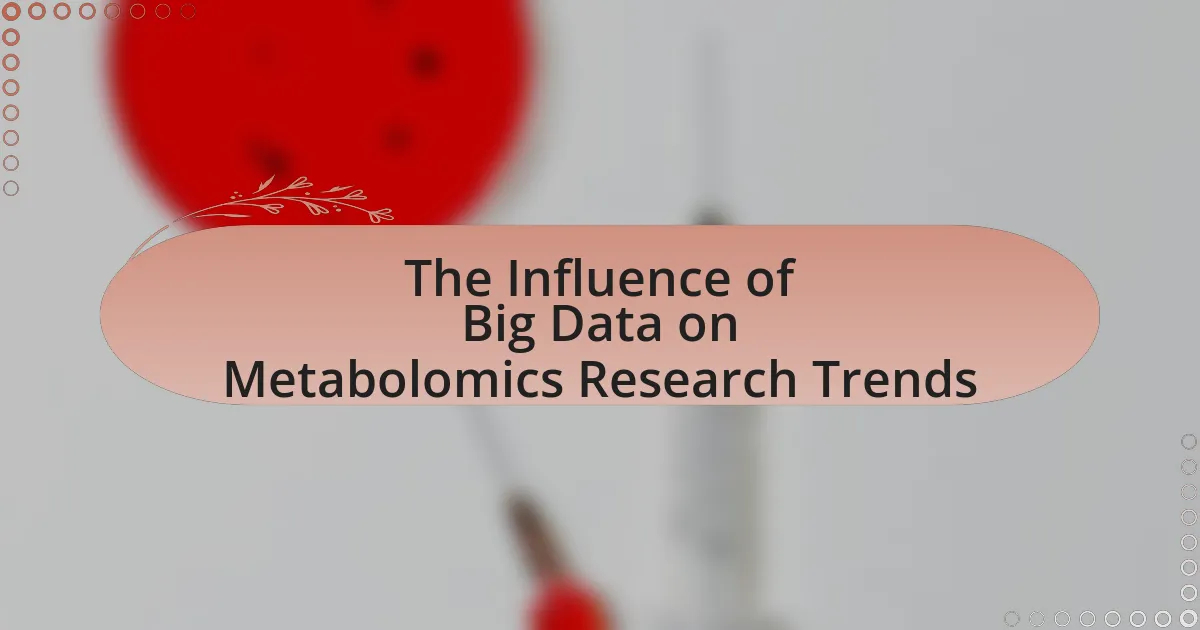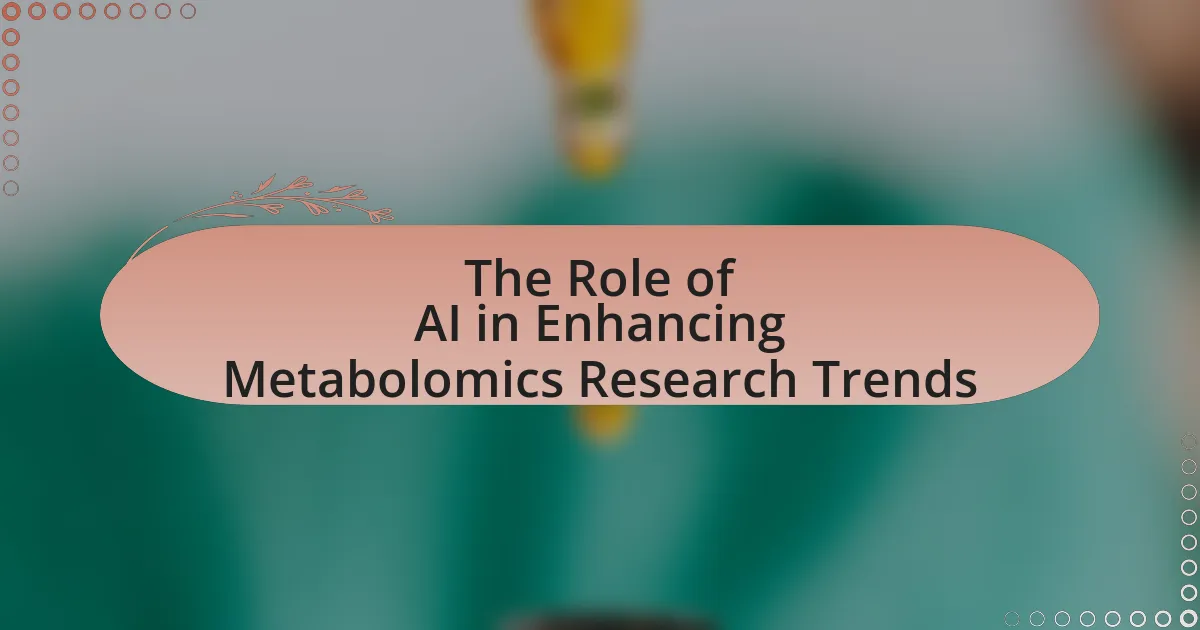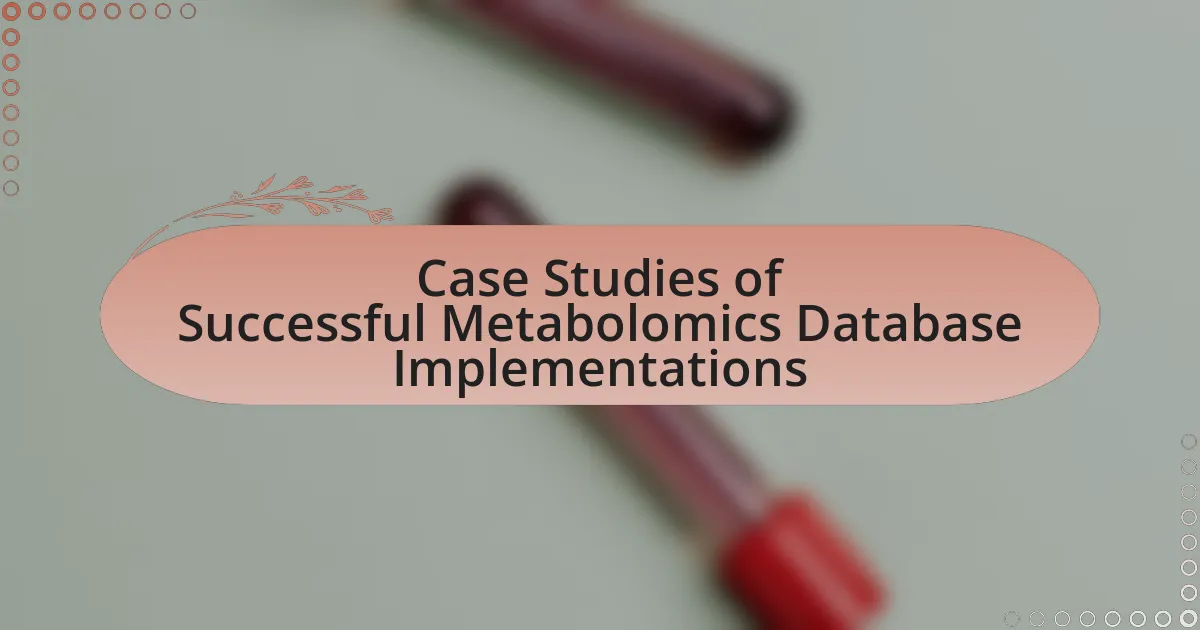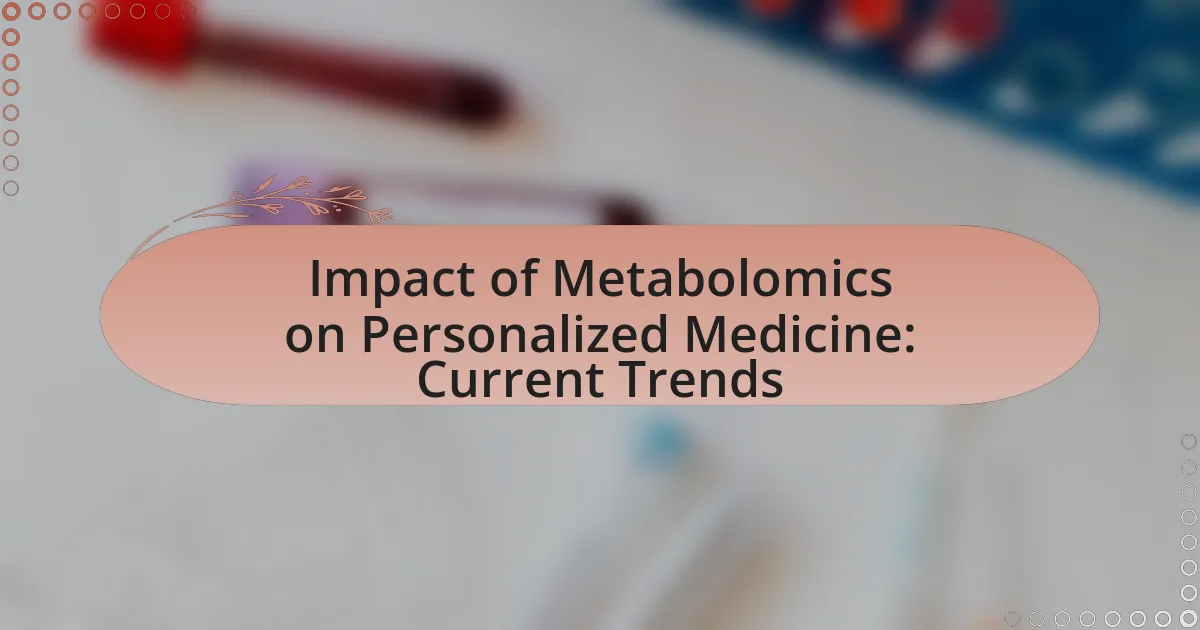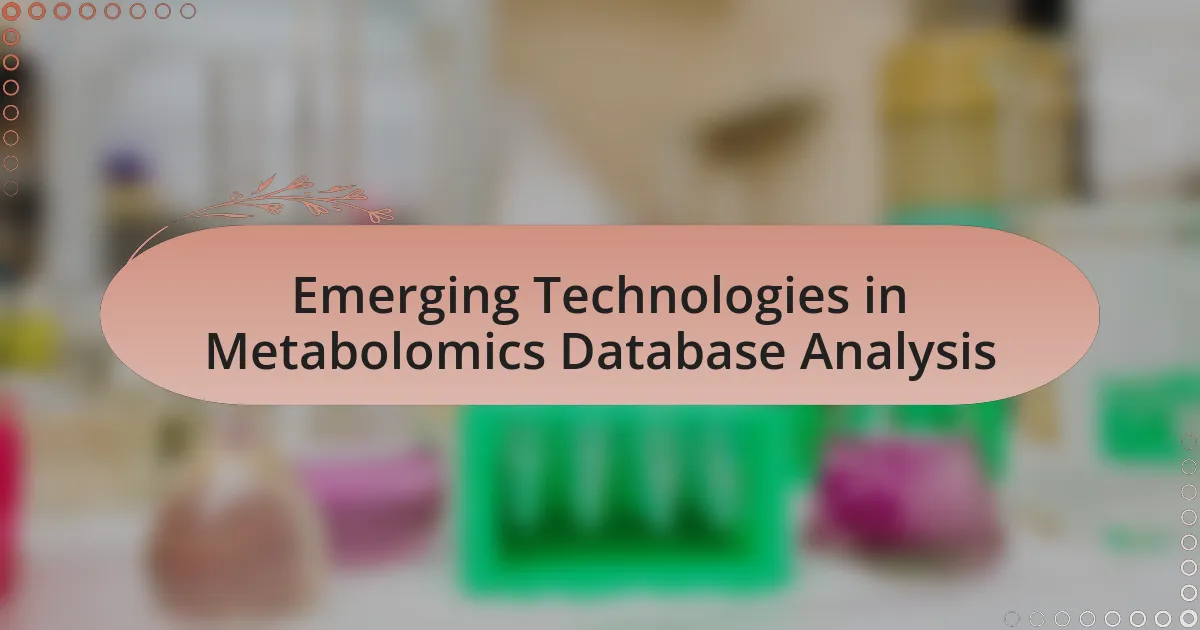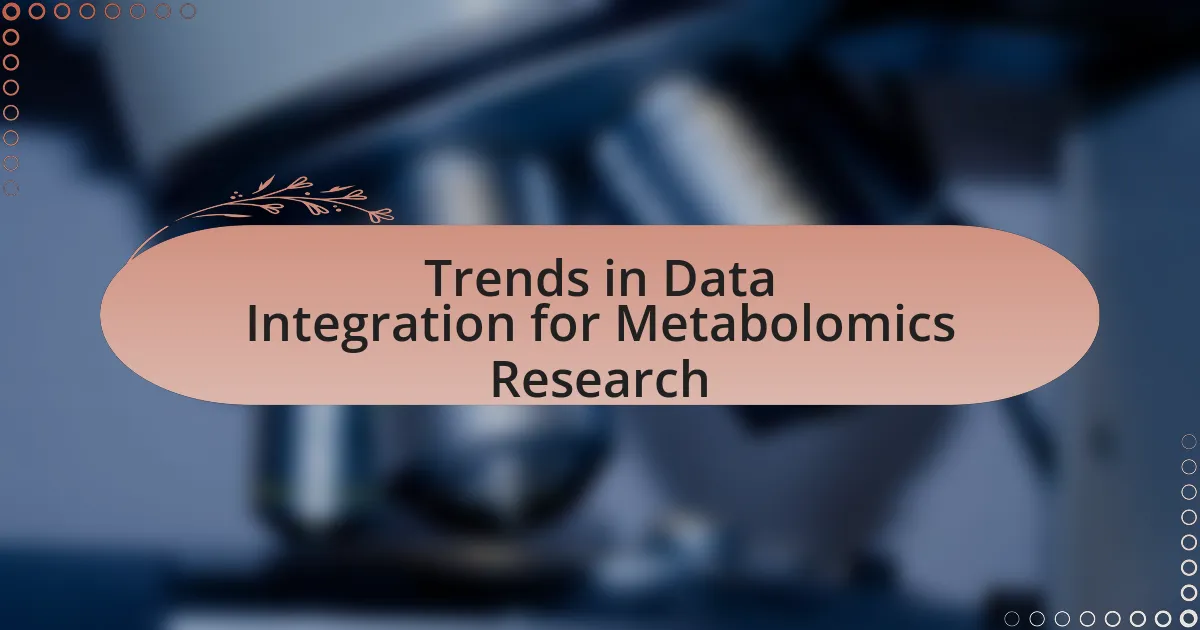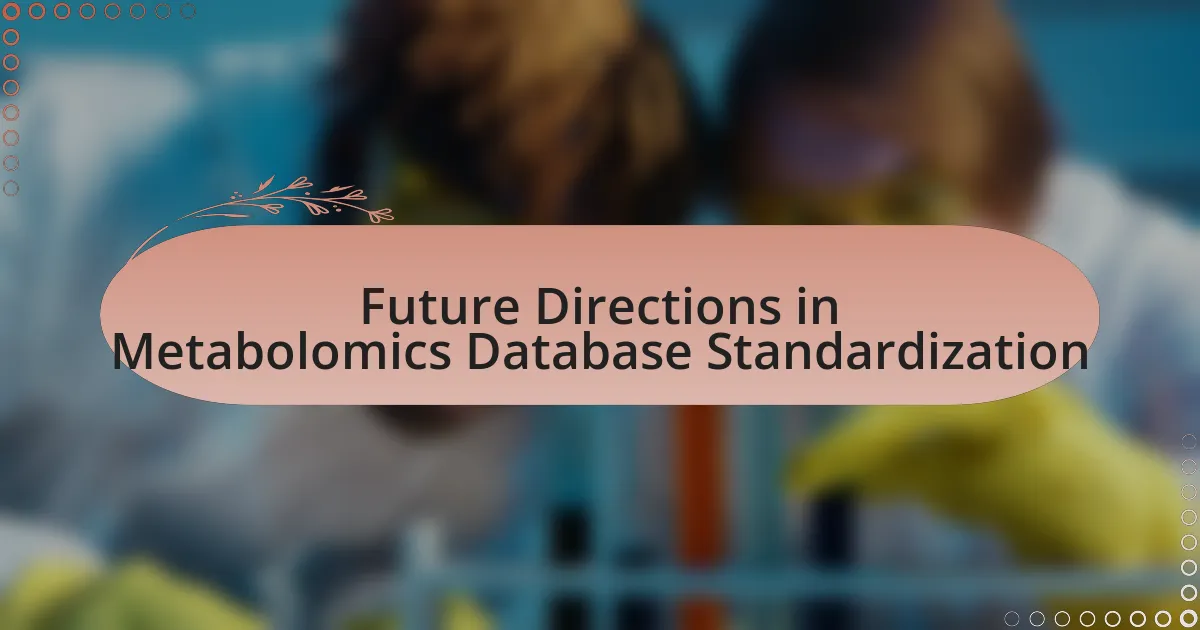Public and private metabolomics databases serve as essential repositories for metabolomic data, with public databases offering free access to a wide range of datasets, while private databases restrict access to authorized users and often contain proprietary information. This article provides a comparative analysis of these two types of databases, highlighting their key characteristics, advantages, and limitations. It discusses the importance of these databases in research, their role in facilitating data sharing and collaboration, and the implications of using each type for research outcomes. Additionally, the article outlines best practices for researchers when selecting between public and private metabolomics databases, emphasizing the impact of accessibility, data quality, and relevance on research integrity.
What are Public and Private Metabolomics Databases?
Public and private metabolomics databases are repositories that store and provide access to metabolomic data, with public databases being freely accessible to all users, while private databases restrict access to authorized individuals or organizations. Public databases, such as the Human Metabolome Database (HMDB), offer extensive datasets that can be utilized for research and analysis without any cost, promoting collaboration and transparency in the scientific community. In contrast, private databases may contain proprietary data that is often curated for specific research purposes or commercial applications, limiting access to those who have paid for or been granted permission to use the data. This distinction is crucial for researchers when selecting resources for their studies, as it influences the availability, cost, and scope of the data they can utilize.
How do Public Metabolomics Databases differ from Private Ones?
Public metabolomics databases are accessible to anyone and typically contain data that is freely available for research and educational purposes, while private metabolomics databases are restricted to specific users or organizations and often require subscriptions or permissions for access. Public databases, such as the Metabolomics Workbench, promote collaboration and transparency in research by allowing broad access to data, which can enhance reproducibility and innovation. In contrast, private databases may offer proprietary data that is curated for specific applications, providing users with specialized insights but limiting the sharing of information. This distinction is crucial for researchers when deciding where to source metabolomics data, as public databases foster open science, whereas private databases may prioritize commercial interests or specific research agendas.
What are the key characteristics of Public Metabolomics Databases?
Public metabolomics databases are characterized by their accessibility, comprehensive data coverage, and community-driven contributions. These databases provide open access to a wide range of metabolomic data, allowing researchers to share and utilize information freely. They typically include extensive datasets from various studies, enabling comparative analyses across different biological conditions and organisms. Furthermore, public metabolomics databases often incorporate standardized data formats and metadata, facilitating interoperability and integration with other biological databases. Examples include the Metabolomics Workbench and the Human Metabolome Database, which serve as valuable resources for the scientific community.
What are the key characteristics of Private Metabolomics Databases?
Private metabolomics databases are characterized by restricted access, proprietary data, and enhanced data security. These databases typically require subscriptions or institutional affiliations for access, ensuring that sensitive information is protected from unauthorized users. Additionally, private databases often contain curated datasets that are not publicly available, providing unique insights and specialized resources for researchers. The proprietary nature of the data allows for exclusive research opportunities and potential commercialization of findings, which can drive innovation in the field.
Why are Metabolomics Databases important in research?
Metabolomics databases are crucial in research because they provide comprehensive repositories of metabolic data that facilitate the identification and quantification of metabolites in biological samples. These databases enable researchers to compare metabolic profiles across different conditions, organisms, and diseases, thereby enhancing the understanding of metabolic pathways and their roles in health and disease. For instance, the Human Metabolome Database contains detailed information on over 40,000 metabolites, which supports various studies in biochemistry and medicine by offering a reliable reference for metabolite identification and functional analysis.
How do these databases facilitate data sharing and collaboration?
Public and private metabolomics databases facilitate data sharing and collaboration by providing centralized platforms for researchers to access, share, and analyze metabolomic data. These databases often include standardized data formats and protocols, which enhance interoperability among different research groups. For instance, public databases like MetaboLights and HMDB allow users to upload their datasets, making them accessible to the global research community, thereby promoting collaborative studies and reproducibility of results. Additionally, private databases may offer controlled access to proprietary data, enabling partnerships between academic institutions and industry, which can lead to innovative research and development. The integration of tools for data visualization and analysis within these databases further supports collaborative efforts by allowing multiple users to work on the same datasets simultaneously, streamlining the research process.
What role do they play in advancing metabolomics research?
Public and private metabolomics databases play a crucial role in advancing metabolomics research by providing accessible platforms for data sharing, analysis, and integration. These databases facilitate collaboration among researchers, enabling the aggregation of diverse metabolomic data sets that enhance the understanding of metabolic pathways and disease mechanisms. For instance, public databases like MetaboLights and HMDB offer extensive repositories of metabolite information, which researchers can utilize to validate findings and generate new hypotheses. Additionally, private databases often provide specialized tools and proprietary data that can lead to novel insights and applications in drug discovery and personalized medicine. The integration of data from both types of databases accelerates the pace of research and fosters innovation in the field.
What are the Advantages and Disadvantages of Public vs. Private Metabolomics Databases?
Public metabolomics databases offer advantages such as accessibility and collaboration, allowing researchers worldwide to share data and findings, which can accelerate scientific discovery. For instance, databases like METLIN and HMDB provide free access to extensive metabolite information, fostering innovation and reproducibility in research.
In contrast, private metabolomics databases provide advantages like enhanced data security and control over proprietary information, which can be crucial for commercial entities. These databases often offer specialized tools and support, catering to specific research needs, as seen in platforms like Metabolon, which provide tailored analysis services.
However, public databases may suffer from issues like data quality variability and lack of comprehensive curation, potentially leading to inaccuracies. Conversely, private databases can be expensive and may limit access to data, hindering broader scientific collaboration. Thus, the choice between public and private metabolomics databases depends on the specific needs and goals of the research being conducted.
What are the benefits of using Public Metabolomics Databases?
Public metabolomics databases offer several benefits, including accessibility, collaboration, and data sharing. These databases provide researchers with free access to a wealth of metabolomic data, facilitating the exploration of metabolic pathways and biomarker discovery without the financial barriers associated with private databases. Furthermore, public databases encourage collaboration among scientists by allowing them to share findings and methodologies, which can lead to advancements in the field. For instance, databases like the Human Metabolome Database (HMDB) and MetaboLights have been instrumental in providing standardized data that enhances reproducibility and validation of research results.
How do Public Databases enhance accessibility for researchers?
Public databases enhance accessibility for researchers by providing free and open access to a vast array of data, which facilitates collaboration and knowledge sharing. These databases, such as the Human Metabolome Database, allow researchers to easily retrieve, analyze, and compare metabolomic data without the barriers of subscription fees or proprietary restrictions. This open access model promotes transparency and reproducibility in research, as evidenced by studies showing that publicly available data sets significantly increase the number of citations and collaborative publications in the scientific community.
What are the limitations of Public Metabolomics Databases?
Public metabolomics databases have several limitations, including data quality, coverage, and accessibility. Data quality can vary significantly due to differences in experimental protocols and data processing methods, leading to inconsistencies in metabolite identification and quantification. Coverage is often limited, as public databases may not include all metabolites or may focus on specific organisms or conditions, which restricts the comprehensiveness of the data available for research. Accessibility can also be an issue, as some databases may have restrictive usage policies or require specific software for data retrieval, hindering broader use by researchers. These limitations can impact the reliability and applicability of findings derived from public metabolomics databases.
What are the benefits of using Private Metabolomics Databases?
Private metabolomics databases offer enhanced data security, allowing researchers to protect sensitive information related to proprietary compounds and experimental results. This confidentiality fosters innovation by enabling companies to maintain a competitive edge without the risk of data theft or unauthorized access. Additionally, private databases often provide curated, high-quality data tailored to specific research needs, which can improve the accuracy and relevance of analyses. Furthermore, they may offer advanced analytical tools and support services that facilitate more efficient data interpretation and integration, ultimately accelerating research outcomes.
How do Private Databases ensure data security and integrity?
Private databases ensure data security and integrity through a combination of access controls, encryption, and regular audits. Access controls limit data access to authorized users only, thereby reducing the risk of unauthorized data breaches. Encryption protects data both at rest and in transit, making it unreadable to anyone without the proper decryption keys. Regular audits and monitoring help identify and rectify vulnerabilities, ensuring compliance with security standards. These measures collectively safeguard sensitive information and maintain its accuracy, as evidenced by industry practices that prioritize data protection in private database management.
What are the limitations of Private Metabolomics Databases?
Private metabolomics databases have several limitations, including restricted access, high costs, and potential data bias. Restricted access limits the availability of data to a select group of users, which can hinder collaborative research efforts. High costs associated with subscription or usage fees can prevent smaller research institutions from utilizing these databases, thereby limiting the diversity of research contributions. Additionally, private databases may exhibit data bias due to selective inclusion of metabolites or studies, which can skew results and affect the generalizability of findings. These limitations can impact the overall effectiveness and inclusivity of metabolomics research.
How do Public and Private Metabolomics Databases Impact Research Outcomes?
Public and private metabolomics databases significantly impact research outcomes by influencing data accessibility, collaboration, and reproducibility. Public databases, such as the Human Metabolome Database, provide open access to a wide range of metabolomic data, facilitating collaboration among researchers and enabling large-scale studies that can lead to breakthroughs in understanding metabolic diseases. In contrast, private databases often contain proprietary data that may offer unique insights but limit access to a select group of researchers, potentially hindering broader scientific progress. The availability of diverse data types from both public and private sources enhances the robustness of research findings, as evidenced by studies showing that integrating data from multiple databases can improve the accuracy of metabolic pathway analyses and biomarker discovery.
What are the implications of using Public Databases for research findings?
Using public databases for research findings enhances accessibility and reproducibility of data. Public databases allow researchers to share and access large datasets, which can lead to more robust findings and facilitate collaboration across institutions. For instance, the Human Metabolome Database provides comprehensive metabolomic data that researchers can utilize to validate their own findings, thereby increasing the reliability of research outcomes. Furthermore, studies have shown that research utilizing publicly available data can lead to significant advancements in fields such as metabolomics, as seen in the work by Wishart et al. (2018) in “The Human Metabolome Database.” This accessibility not only democratizes research but also accelerates scientific discovery by enabling a wider range of researchers to contribute to and build upon existing knowledge.
How do Public Databases influence reproducibility in research?
Public databases enhance reproducibility in research by providing accessible, standardized datasets that allow researchers to validate and replicate findings. These databases, such as the Metabolomics Workbench and the Human Metabolome Database, offer comprehensive collections of metabolomic data that can be utilized across various studies. By enabling independent verification of results, public databases reduce variability and bias, which are critical for reproducibility. Studies have shown that research utilizing publicly available data tends to have higher reproducibility rates, as evidenced by a systematic review published in Nature, which highlighted that access to shared data significantly improves the reliability of scientific conclusions.
What are the challenges faced when relying on Public Databases?
Public databases face several challenges, including data quality, accessibility, and privacy concerns. Data quality can be inconsistent due to varying standards of data collection and curation, which may lead to inaccuracies in research findings. Accessibility issues arise when databases are not user-friendly or when data is not easily retrievable, hindering researchers’ ability to utilize the information effectively. Privacy concerns are significant, especially when databases contain sensitive information, leading to potential ethical dilemmas regarding data usage. These challenges can impact the reliability and applicability of research conducted using public databases.
What are the implications of using Private Databases for research findings?
Using private databases for research findings can lead to issues of accessibility, reproducibility, and potential bias in data interpretation. Private databases often restrict access to data, which can hinder collaboration and limit the ability of researchers to validate findings independently. For instance, a study published in “Nature Biotechnology” highlights that proprietary data can create barriers for researchers who lack the necessary permissions, ultimately affecting the transparency of research outcomes. Additionally, the selective nature of data included in private databases may introduce biases, as these databases may not represent the full spectrum of available data, leading to skewed results.
How do Private Databases contribute to proprietary research advancements?
Private databases significantly enhance proprietary research advancements by providing exclusive access to curated, high-quality data that is not available in public repositories. This exclusivity allows researchers to conduct more targeted and innovative studies, as they can leverage unique datasets that may contain proprietary information or specialized analyses. For instance, private databases often include proprietary metabolomics data that can lead to breakthroughs in drug discovery or personalized medicine, as they offer insights that are tailored to specific research needs. The ability to access and analyze this specialized data accelerates the research process and fosters the development of novel methodologies, ultimately contributing to advancements in the field.
What are the challenges faced when relying on Private Databases?
Relying on private databases presents several challenges, including limited accessibility, high costs, and potential data silos. Limited accessibility arises because private databases often restrict user access, making it difficult for researchers to obtain necessary data. High costs can be a barrier, as subscription fees or licensing agreements may be required, which can strain research budgets. Additionally, data silos occur when information is not shared across platforms, hindering collaboration and comprehensive analysis. These challenges can impede research progress and limit the overall utility of the data contained within private databases.
What best practices should researchers follow when choosing between Public and Private Metabolomics Databases?
Researchers should prioritize data accessibility, quality, and relevance when choosing between public and private metabolomics databases. Public databases often provide free access to a wide range of datasets, which can enhance collaboration and reproducibility in research. However, private databases may offer curated, high-quality data with specific focus areas that can be beneficial for targeted studies.
Additionally, researchers should evaluate the database’s update frequency and community support, as these factors influence the reliability and usability of the data. For instance, databases like MetaboLights and HMDB are well-regarded public resources, while proprietary databases may offer unique datasets not available elsewhere. Ultimately, the choice should align with the specific research goals and the need for data integrity and accessibility.
